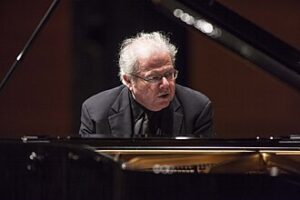By Eileen Wingard


SAN DIEGO —Emanuel Ax, one of the great American-Jewish pianists of our time, opened the October 20 San Diego Symphony concert playing Mozart’s Piano Concerto #25 in C major. This lesser-known Mozart Concerto, with simple themes built on triads, scales and familiar rhythmic motifs, displayed Mozart’s innovative development skills.
The first movement opened with a lengthy orchestral introduction and the piano entered subtly, then asserted itself in thematic statements and elaborations. The cadenza was a further display of Ax’ technical prowess. The slow movement was characterized by sensitive tranquility and the final movement, in sonata-rondo form, opened with a jaunty gavotte theme, quoting from the composer’s opera, Idomineo, and returning several times throughout the movement.
The dream-like flute solo, representing Juliet, later scored near the end for a solo violin, was particularly touching. For this listener, it brought back memories of seeing the great Russian ballerina, Galina Ulanova, dancing the role of Juliet at the Bolshoi Theater in Moscow in 1960. My husband and I were on Fulbright stipends, he as an exchange teacher in Tauberbischofheim, where we lived, and I as a scholar at the Hochschule fuer Musik in Stuttgart, Germany, to where I commuted. During the three-week Easter Holiday, we were in Berlin for a conference after which we were able to book passage on the first group trip from Germany to the Soviet Union. One night, while in Moscow, my husband baby-sat our two year old daughter, Myla, and I was able to see Prokofiev’s Romeo and Juliet Ballet at the Bolshoi Theater. I will never forget the famous Russian ballerina, Galina Ulanova, her limpid body delicately portraying the teenage Juliet. Ulanova was 50 years old at the time. I have seen other great ballerinas dance the role since, but none compared to the great Russian dancer.
Unfortunately, the three talented actors for the SDSO Romeo and Juliet creation were difficult to hear, although I was seated in Row J in the middle of the Orchestra section. Juliet’s words were more audible, and some of Romeo’s, but most of the narrator/Friar Laurence’s dialogue was lost because of the speed at which the words were spoken. The acoustics in the Jacobs Music Center are obviously better for music than for the spoken word. With the addition of the theatrical elements, and more sections of the ballet score, the work took an hour and twenty minutes, far longer than the 35 minute Romeo and Juliet Suite from the Ballet, normally programmed at symphony concerts.
However, in spite of this problem, we applaud the San Diego Symphony for attempting new creative endeavors to interest younger audiences and bring classical music to more people. Future creative enhancements by McBurney will include Stravinsky’s Firebird Ballet music and music from Wagner’s opera, Die Walkure, to be presented later in the season at the Rady Shell.
Although not all elements came together as successfully as planned, this was another opportunity to hear our magnificent San Diego Symphony Orchestra performing at its best in the Jacobs Music Center under its world-class conductor, Raphael Payare.
*
Eileen Wingard, a retired violinist with the San Diego Symphony Orchestra, is a freelance writer specializing in coverage of the arts.